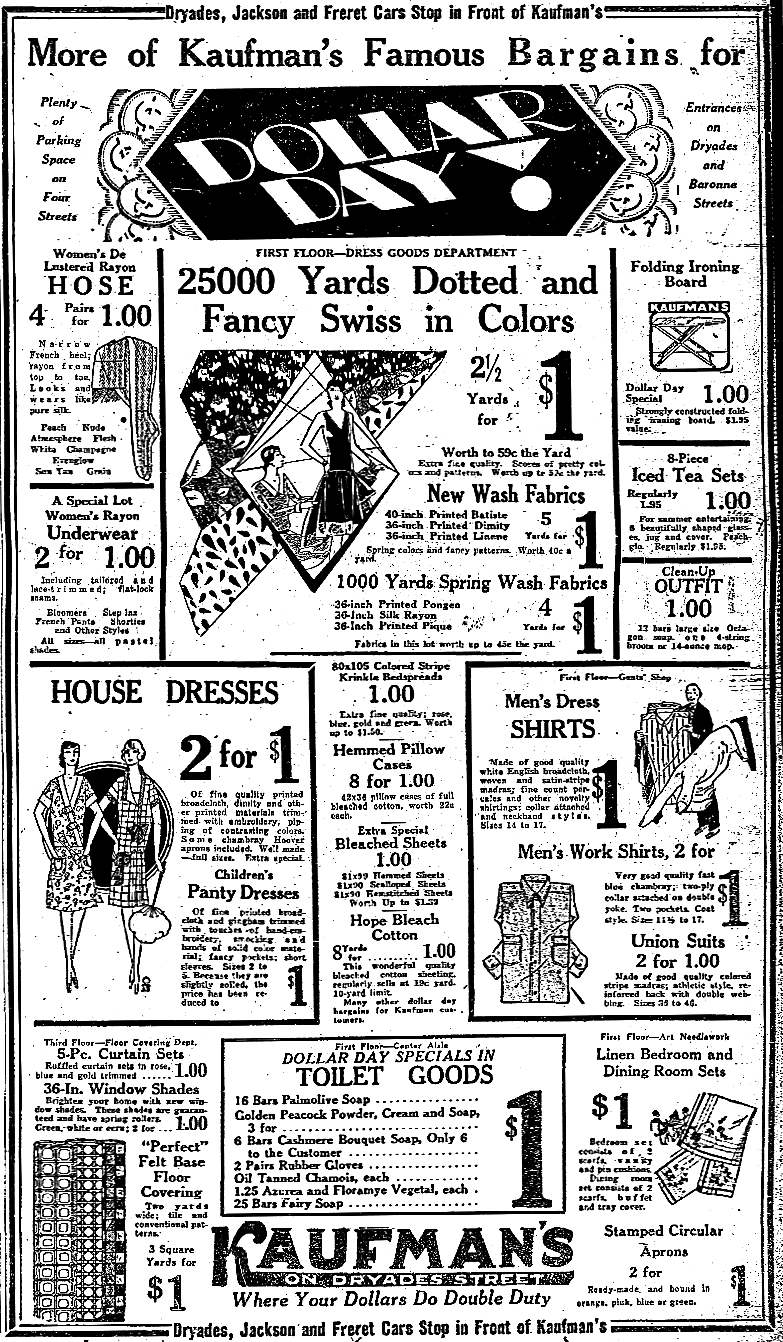|
Today in New Orleans History |
|
|
April 18



 

To receive an update for each day in New Orleans
history, join our facebook page
- Today in New Orleans History
The Canal Street streetcar line traces its origins to the old New Orleans City Rail Road Co., founded
to provide horse-drawn streetcar service throughout the city. This system's first lines opened in June 1861, running on
Esplanade, Magazine, Prytania, and Canal Streets. The original car barn for the Canal Line, which served it until the end
in 1964, was established at White Street. The line ran on its namesake street from St. Charles Street to the car barn; it
was extended in August all the way to the end of the street at the Cemeteries. The City RR came under the control of the
New Orleans Traction Co. in 1892 as the system was prepared for electrification. A large order for new electric streetcars
was placed with the Brill Co. of Philadelphia. The Canal Line was the first New Orleans Traction line to be electrified,
beginning electric service on July 28, 1894. It was followed very quickly by Esplanade and the rest of the company's horsecar
lines. The line was extended slightly in the central business district to terminate at the foot of Canal Street. In 1901,
the streetcar company slightly extended the Canal and Esplanade Lines so that their outer ends met at City Park Ave., and
connected them together in a Belt Line. Canal cars left the central business district on Canal Street, operated to City
Park Ave., turned down that street to Esplanade Ave., and returned on Esplanade to Rampart and thus back to Canal Street.
Cars marked Esplanade left the central business district via Rampart Street down to Esplanade, then operated out Esplanade
to City Park Ave. to Canal, and returned on Canal Street. This Belt Line arrangement lasted until December 27, 1934, when
Esplanade Ave. was converted to buses, and Canal resumed running only on Canal Street, end-to-end. From 1934 to 1950,
there were two lines running on Canal Street. Cars marked West End operated from the foot of Canal to the outer end of the
street at the cemeteries, then turned left onto City Park Ave. (Metairie Road) to the New Basin Canal, and then out the
east bank of that canal to the West End amusement area at Lake Pontchartrain. Cars marked Cemeteries followed the same route,
but turned back at the cemeteries immediately after turning off of Metairie Road. West End made only limited stops along
Canal Street from Claiborne Ave. to City Park Ave. The West End line was converted to buses in 1950, after which the surviving
Cemeteries cars were once again signed Canal. In 1951, the outer terminus of the Canal Line was moved to the end of Canal
Street, and tracks on City Park Ave. (Metairie Road) were removed. In 1964, the streetcar company (known since 1922
as New Orleans Public Service Incorporated, or NOPSI) proposed to convert the Canal Line to buses. The line was to be combined
with the West End and Canal Blvd. bus lines, so that patrons could have a one-seat ride all the way from the central business
district to Lake Ponchartrain. There was tremendous controversy over the proposal, but it was carried, and the Canal Streetcar
was discontinued, over the protests of preservationists. The last day was May 30, 1964, with the final run (NOPSI car 972,
carrying banners which read "See Me On St. Charles") leaving Canal Line tracks at about 5:00 a.m. May 31. All
the streetcars, except for 35 reserved for the St. Charles Line, were scrapped or donated to museums across the country,
and all track and overhead wire was removed. By the 1990s, interest in streetcars was rekindled, not only in New Orleans,
but in many cities around the country. Plans for the restoration of the Canal Line were announced in 2000, and tracks were
rebuilt from the foot of Canal Street out to the cemeteries. There was even a branch line created on N. Carrollton Ave.,
which had never before had streetcar service. Finally, the Canal streetcar line reopened April 18, 2004,
almost 40 years after its close.
A Beech Air King aircraft, Model 200, crashed into Lake Pontchartrain on April 18, 1977.
The owner of the aircraft was Tidewater Marine Service. Five persons were killed in the crash, including Gerald Sievers,
who was employed by Tidewater as one of the two pilots for the aircraft. The aircraft departed New Orleans International
Airport at about 9:35 p. m. The flight progressed normally until the time it was positioned by radar for its landing
approach. Following the radio acknowledgment from the aircraft of routine traffic advisories, the radar controller noted
that the aircraft began to lose altitude and to deviate from its assigned course. The controller attempted to warn the aircraft
of its loss of altitude several times, however, the controller received no response from the aircraft. Shortly thereafter,
the aircraft disappeared from the controller's radar scope, and the Coast Guard and Parish Sheriff's Office were notified
that the aircraft had probably crashed in the western area of Lake Pontchartrain. From http://www.leagle.com/decision/1980694497FSupp197_1665 On April 28, 1862, Admiral David Farragut's troops took possesion of New Orleans for the Union. Angus Lind's First Column Published In'na Paypa April 18, 1977 Born in New Orleans on October 8, 1944, Angus Miller Lind's byline first appeared in The Greenie --
the student newspaper of his school, Isidore Newman. He then wrote for the Tulane Hullaballoo. His first
professional job in journalism was as a sports writer for the Meridian Star (Meridian, Mississippi) where he became the sports
editor who covered the Southeastern Conference and the college careers of Archie Manning and Pete Maravich. In December of 1970 he moved back home for good and began working as a general assignment reporter for the
States-Item (the after-noon paper) where he covered (among other top stories) the plane crash of U.S. Representative Hale
Boggs in Alaska, the Downtown Howard Johnson sniper incident, the Rault Center and the Upstairs Lounge fires, and the construction
of the Superdome and unique stories such as alleged vampire and UFO sightings, and the nationally popular streaking phenomena
at Tulane. Regarding his time at the Item, he said, "We worked hard, getting in at the crack of dawn, making three
different deadlines, and then we partied -- almost every day. We all seemed to have the attitude that in New Orleans,
if you die of old age, it's your fault." His first column was published on April 18,
1977, titled "What's a Yat?", and is generally acknowledged as the first printed account of the expression
"Where y'at?". When the States-Item merged with the Times-Picayune in 1980, Lind stayed onboard and included
in his columns real New Orleans characters, such as "Black Cat" Lacombe, "Leapin' Lou" Messina, Buddy
Diliberto (and the "torn lee knigaments" of Saints quarterback Dave Wilson), Abdul D. Tentmakur, Morgus the Magnificent
(Sid Noel) and horse racing afficandos Hard Times Vince, Cream Cheese Louie, Rooster and The Mullet. His original creations
included Deep Float (distant cousin of Watergate informant Deep Throat) who infiltrated Carnival dens, stole mystic secrets
and parade themes, and leaked them as well as Karnak the Magnificent, who was the keeper of mystic secrets about Tulane and
LSU football. On May 31, 2009, he announced his retirement in his final column titled "Thirty-nine years and 6,000 columns after he started, Angus Lind holsters his golden quill and rides away".
He recalled that during his long and much loved career, "I met a lot of interesting and colorful and quirky people,
and I learned that they almost all have a story, whether they know it or not." After retiring, Lind authored Prime Angus: Readers' Favorite Columns Reprinted From the Pages of The Times-Picayune |
|
|

To receive an update for each day in New Orleans history,
join our facebook page - Today in New
Orleans History.
Analytics |



